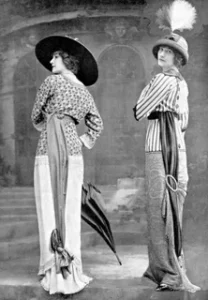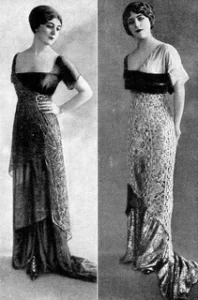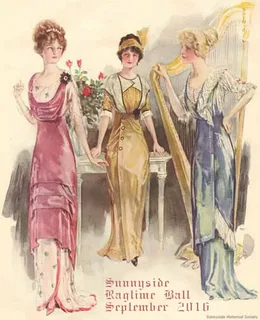1912 Women’s fashion was at a fascinating crossroads. The Edwardian era was drawing to a close, and with it, the stiff, corseted styles that had dominated for decades. At the same time, hints of modernity began to emerge. This period was marked by a shift towards more relaxed and practical clothing, although elegance and femininity were still key.
From the luxurious dresses worn by upper-class women to the everyday attire of working women, 1912 women’s fashion provides a captivating glimpse into an era of transformation. Let’s explore the key trends, influences, and iconic styles of the time, as well as the shift in fashion norms that helped pave the way for the roaring ’20s.

The Edwardian Silhouette: From S-Curve to Soft Lines
In 1912 Women’s Fashion, the Edwardian silhouette was still prominent, but its defining feature—the S-curve shape—was fading out. Earlier in the Edwardian era, women’s bodies were sculpted into an exaggerated shape using corsets, which pushed the bust forward and the hips back. By 1912, women’s fashion was moving away from this extreme, with clothing embracing a more natural figure.
- Corsets were still worn, but they had evolved to be longer, reaching down to the hips, which created a straighter, less exaggerated line.
- Skirts were becoming narrower, but they still had some fullness, especially around the hips.
- Blouses were often loose and flowing, featuring delicate lace, ruffles, and high necklines.
This shift in silhouette was a sign of the changing attitudes towards 1912 Women’s Fashion, as practicality began to take precedence over rigid beauty standards. The styles were becoming more relaxed, yet they retained the grace and femininity that defined Edwardian fashion.
Influence of Art Nouveau and Orientalism
1912 women’s fashion was heavily influenced by two artistic movements: Art Nouveau and Orientalism.
- Art Nouveau, with its flowing lines and organic shapes, inspired the intricate designs seen in women’s clothing. Embroidery, lace, and embellishments often featured motifs such as flowers, vines, and birds, giving garments an air of natural beauty.
- Orientalism introduced luxurious fabrics like silk and velvet, as well as kimono-inspired cuts and exotic patterns. The fascination with Eastern cultures brought brighter colors and bold prints into mainstream 1912 Women’s Fashion
These artistic influences gave 1912 women’s fashion a unique blend of elegance and exotic flair. Women were drawn to the opulence of Art Nouveau and the exoticism of Orientalism, and these trends were reflected in both high fashion and everyday wear.
Daywear vs. Evening Wear: Dressing for the Occasion
In 1912, women’s fashion was distinctly categorized into daywear and evening wear, each with its own set of expectations and styles.
Daywear:
- High-neck blouses paired with long skirts were the standard.
- Hats were essential, often wide-brimmed and adorned with feathers, flowers, or ribbons.
- The daywear was practical but still elegant, made from durable fabrics like wool or cotton.
Evening Wear:
- Evening gowns were often made from luxurious materials like silk or velvet.
- These gowns featured low necklines and were often sleeveless, with flowing skirts that created a soft, romantic silhouette.
- Jewelry and gloves were crucial accessories for formal events.
While daywear focused on modesty and practicality, evening wear was an opportunity for women to showcase their femininity and wealth.
Fashion for the Working Class
While the upper class enjoyed the luxury of ornate, custom-made clothing, working-class women had a more practical approach to fashion in 1912.
- Simple skirts and blouses were the standard for everyday wear, often made of cheaper materials like cotton or wool.
- Aprons were commonly worn to protect clothing, especially by women working in domestic service or factories.
- Despite the practical nature of their clothing, working-class women still followed trends, opting for simple versions of the fashionable silhouettes and styles seen in wealthier circles.
The Role of Women’s Suffrage in Fashion
1912 was also a significant time for women’s rights, with the women’s suffrage movement gaining momentum. Fashion played an important role in this movement.
- Many suffragettes adopted more practical clothing, such as tailored suits and blouses that allowed for easier movement.
- The color white became a symbol of purity and the suffrage movement, often worn at rallies and protests.
The suffrage movement helped to challenge traditional gender norms, and this shift was reflected in the clothing women wore. The desire for more comfortable and practical clothing was directly linked to the changing roles of women in society.

Accessories and Hairstyles
No discussion of 1912 women’s fashion would be complete without mentioning the accessories and hairstyles that completed the look.
- Hats were large and elaborate, often decorated with feathers, flowers, and ribbons.
- Gloves were a must-have for women of all social classes, with longer gloves reserved for formal occasions.
- Hairstyles in 1912 were soft and voluminous, with women often wearing their hair in loose updos or waves.
These accessories added to the overall elegance of women’s fashion in 1912, completing the look and adding a touch of refinement.
The Evolution of 1912 Women’s Fashion
1912 was a transitional year in fashion. The rigid corsets and S-curve silhouettes of the early Edwardian era were giving way to more comfortable and practical clothing, as women began to demand more freedom in their clothing choices.
This shift paved the way for the bold and liberated styles of the 1920s, with women’s fashion moving towards shorter skirts, looser cuts, and less restrictive undergarments. The fashion of 1912 can be seen as a stepping stone towards modern women’s fashion, combining elegance and practicality in a way that reflected the changing roles of women in society.
FAQs
What was the silhouette of 1912 women’s fashion?
The silhouette in 1912 was moving away from the exaggerated S-curve of the early Edwardian era, favoring a straighter, more natural shape.
What fabrics were popular in 1912 women’s fashion?
Luxurious fabrics like silk, velvet, and lace were popular in high fashion, while cotton and wool were commonly used for everyday wear.
How did the suffrage movement impact women’s fashion in 1912?
The suffrage movement influenced women’s fashion by encouraging more practical and comfortable clothing, such as tailored suits and blouses, symbolizing the changing role of women in society.
What were popular accessories in 1912?
Large hats, gloves, and jewelry were essential accessories for women in 1912, adding elegance to both daywear and evening wear.
In summary, 1912 women’s fashion represents a moment of transition, blending the luxurious elegance of the Edwardian era with the early signs of modernity. This era laid the foundation for the more liberated styles that would soon emerge, making it an essential chapter in the history of women’s fashion.
Read more: womenfashionwear.site

